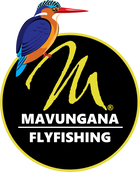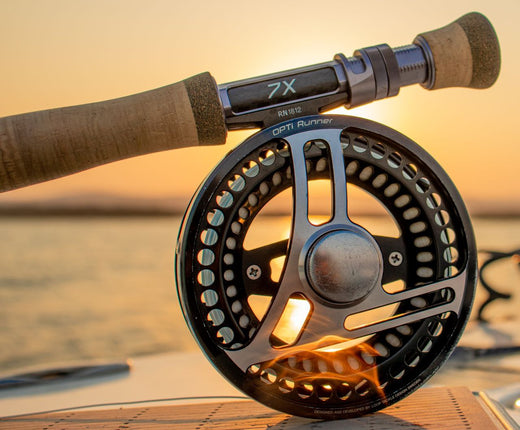Having covered fly rods and fly lines already in this series, we now look at the world of fly reels. We focused on rods and lines first because we feel they rank higher in importance in most cases when comparing gear. A good line is a must, and will make your experience that much better, be it on Nubian flats or a chalk stream in the UK. When it comes to fly reels, this is where you need to ask yourself a series of questions based on application and preference.
We’ve all heard the saying, “the reel simply stores the line” which is often connected to trout fishing. Yes and no. You might not be fighting 80% of the trout you catch in Dullstroom on the reel, however, a smooth drag goes a long way. Not a powerful drag, but a smooth one. Picture this, it’s an early spring morning in the highlands of Dullstroom, you’re up before the golden light starts illuminating the water and hills in the background. Mist rising up off the water, a gentle breeze, and trout rising in the margins. You slowly wade through the tall grass, lining up your cast parallel to the bank. You’ve just lengthened your leader to 16 ft by adding a meter of 5X fluoro and a Size 14 Stimulator. You make your cast, landing 4 feet shy of the rising fish, you straighten your line and wait. You watch the mouth of an 8lb cock fish come up, engulf your fly and turn – inside! He immediately heads for deeper water, and within seconds you’re onto your reel and your bright orange floating line is disappearing at a rate of knots. A powerful drag set too high will get you nowhere in this scenario, and definitely end in a popped knot with a fish to remember now swimming away with your Stimulator. So, with that said if you’re looking for a trout reel, consider this.

Where and What?
Where are you planning on using this reel the most, and for what species. Most south Africans start with a 5wt rod, covering bass, trout and yellowfish comfortably. You’ll use the reel far more when fishing for yellows, be it on Sterkfontein using 5X and 6X tippet, or the Vaal River where you now have to consider landing fish in a fast-flowing current. You don’t need to break the bank, you can get an affordable reel with decent drag at a good price. Where this changes is the moment you enter the salt, or need to turn big predatory fish. Then your reel goes from being the third item of gear to consider, to the first. You’re more likely to lose a big fish or have your reel seize, than you are to have a rod break when fishing, and especially wading, in salt water. So, let’s look at what you need in a good reel that will handle these scenarios:
- The drag – you have two types of drags. Sealed and disk drag. Each have their pros and cons which we’ll touch on later. Either way, you need a drag that is adequate to get the job done. If you’re targeting Geets in the Indian Ocean, you need 12 lbs plus of drag, ideally looking at 15 lb to 20 lb in a 12 wt reel. If you need a 9 wt reel, then not as much drag is required, and we’d look at the following a bit more closely.
- Arbour – a small arbour reel is incredibly frustrating. You need the ability to pick up as much line with every turn of the drag knob as possible, and a small arbour does not cut it; rather get a large arbour reel from the outset. Larger arbour reels also have the benefit of reducing memory in the line and helps prevent your line looking like a Slinky spring toy when you peel line off after it hasn’t been used for a while.
- Drag knob – this is often overlooked, but the ideal drag needs to go from fully loosed, to fully tighten in one revolution. You don’t have time to waste when that milkfish makes its first run, or when you need to swing the rod from one side of the boat, around the bow, to the other. Being able to loosen your drag quickly while doing this can be imperative to landing that fish.
- Weight – some of the most reliable reels on the market are also very heavy, and a heavy reel on a rod you’re casting all day can tire one out very quickly. If you’re sight fishing then this becomes less on a consideration, but if you’re targeting Nile Perch at night, blind casting for hours in the darkness, then you need to take this into consideration.

Disk or Sealed
Most high-end freshwater reels are sealed drag reels. Whereas the moment you look at 8 wt reels and heavier, you’re now crossing into the territory of sealed vs disk. A sealed drag requires very little maintenance, as long as you’re washing your reels off with fresh water to get rid of the salt, you’ll maintain your reel. However, not all top end reels are made equal. This is where we would highly recommend enquiring with a guide or the operator of the destination you’re heading to, or the local fly shop manager to get an informed opinion. When it comes to disk drags, the main advantage here is that its like an AK47. Very few moving components, and thus easier to fix or replace in the event of something going wrong. It will however require more maintenance. If your sealed drag reel malfunctions, you’re not allowed to open up the drag to see what’s wrong, or you’ll void the warrantee. You have to send the reel back to the manufacturers which can be a lengthy process, especially considering that you’ll be sending a reel from South Africa to either the UK or US. At the end of the day, it’s the age-old Land Rover vs Toyota dispute. It boils down to preference, but you will get what you pay for.

Circling back to lighter reels you’d use in freshwater, you need to ask yourself if you’ll be changing lines often, in which case you need to consider spare spools or possibly a cassette reel. Either way, a large arbour is preferred. You’ll minimise line memory and when it comes to having to actually use the reel to fight a fish, you’ll thank us later. Balancing your rod and reel, although not high on the list of factors to consider, if you’re fishing a very short, light rod – or quite the opposite, a nymphing or boat rod between 10 and 11ft, you’ll want to match the reel accordingly. A light reel on a light rod, and a heavier reel on a longer rod. This will help balance your setup and feel better when casting.
So, consider where you’ll be using the next reel you’re looking to purchase, what species you intent on targeting and then start narrowing down your choice by asking the aforementioned questions. Often overlooked and trumped by the latest or most colourful reel sitting on the shelf, rather purchase the right reel than simply a good one.

